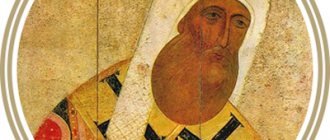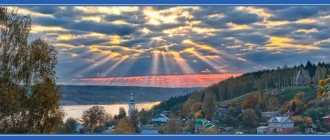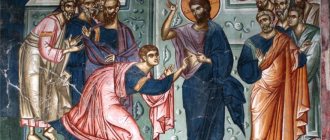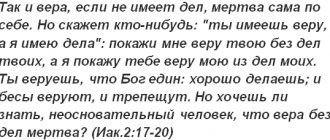The history of the formation of Orthodoxy in Rus' is inextricably linked with a number of individuals who dedicated their lives to the true worship of God and the fulfillment of all Divine laws. Strictly following the requirements of their religion, these people deserved Divine grace and the title of Orthodox saints for their selfless service to the Almighty and intercession for the entire human race before him.
The list of godly personalities who became famous for righteous deeds or who suffered for the faith of Christ is truly inexhaustible. Nowadays, it is also replenished with new names of pious Christians canonized by the church. The acquisition of holiness by ascetics of spiritual improvement can be called a great work, coupled with the burden of overcoming base feelings and vicious desires. Creating the Divine image in oneself requires enormous effort and painstaking work, and the feat of Orthodox saints awakens admiration in the souls of true believers.
On icons depicting the righteous, their heads are crowned with a halo. It symbolizes the grace of God, illuminating the face of a person who has become a saint. This is God's gift, warming the soul with the warmth of spirituality, delighting the heart with Divine radiance.
Hierarchy of the miracle-working fathers of the Orthodox Church
Through prayers in churches and prayer chants, clergy, together with believers, glorify the image of the earthly life of the righteous according to their rank or title. Taking into account the feats accomplished during life or the reasons for leaving for another world, on the pages of the Orthodox calendar compiled by the Russian Orthodox Church, lists of pious persons by rank are presented.
- Prophets. This is the name given to the Old Testament saints, endowed with the gift of foreseeing future events. The Prophets were chosen by the Almighty; they were called upon to prepare the people for the acceptance of Christianity.
- The best followers of the Lord are called apostles. Of these, 12 saints are called close, the ranks of the disciples of the Heavenly King number 70 righteous people.
- The Forefathers include the pious men mentioned in the Old Testament, who were distantly related to our Savior.
- Righteous men or women who have accepted monastic rank (monasticism) are called venerables.
- The status of great martyrs or martyrs is given to God-pleasers who died a martyr's death for the faith of Christ. Servants of the church are classified as hieromartyrs, sufferers in monasticism - venerable martyrs.
- Among the Blessed are the pious who have become insane for Christ's sake, as well as travelers without a permanent home. For their obedience, such people were gifted with God's mercy.
- Enlighteners (equal to the apostles) are called righteous people whose actions contributed to the conversion of peoples to the Christian faith.
- Passion-bearers or confessors are the name given to pious believers who were subjected to persecution and imprisonment for their devotion to the Savior. In the world, such Christians died in great pain.
Prayers to the holy saints are associated not only with the veneration of God’s companions, but with turning to them for their own help. Showing Divine honors and worshiping anyone other than the true and one God is prohibited according to the Holy Scriptures.
Saints.
From Byzantium, Rus' adopted the custom of electing bishops from the monastic clergy. However, holy bishops - hierarchs - the third most important rank of Russian holiness, are glorified by the Church not for ascetic deeds, although monastic traits are one way or another present in the image of any bishop. The saint’s feat combines monastic, secular, and church service. Its meaning is teaching, protecting the purity of faith, and serving the salvation of one’s flock. Unlike Byzantium, the Russian Church never knew the tradition of canonizing all its hierarchs by virtue of their holy orders. The saint was glorified when he achieved personal holiness through his life and service to the church. Typical features of the Russian saint are generous alms, concern for the founding and decoration of churches and monasteries, secret asceticism, strict implementation of the principle of civil justice, and severity in the fight for truth. The first saint to receive all-Russian recognition was Niphon of Novgorod (11th century), who combined the talents of a politician and a peacemaker, which allowed him to achieve peace by pacifying the warring princes. The teaching calling of the ancient Russian saint was primarily expressed in preaching the Gospel among the pagans. Among such evangelists are the Rostov saints. Leonty and Isaiah (11th century), who once enjoyed universal veneration in Rus'. A special place among Russian saints belongs to Stephen of Perm (14th century). St. Stephen of Perm, one of the most educated people of his time, devoted his life to missionary work among the Zyryans (Komi). He created the Zyryan alphabet and translated liturgical texts into the Zyryan language. As a missionary, St. Gury Kazansky (16th century). Not far from Kazan, he founded the Zilantov monastery, which became the first missionary school in Rus'. In modern times, such holy hierarchs as Innocent of Irkutsk, John and Paul of Tobolsk, and Nicholas of Japan have worked in the field of the Gospel. Public, state service constitutes the essence of the feat of many famous Novgorod rulers, who occupy a special place among Russian saints. Until the Novgorod Republic lost its independence, they were its de facto rulers and became famous for the construction of temples, stone chambers, the activities of scriptoria, generous alms given not only to Russian churches, but also to Constantinople (Constantinople), Athos and Jerusalem. Political activity strongly colors the church service of the Moscow metropolitans: Peter, Alexy and Jonah. However, unlike the Novgorod rulers, who defended the local interests of the Novgorod Republic, the Moscow metropolitans pursued policies that had national significance. The most complete image of a bishop-ruler was created in the life of Metropolitan Alexy, who worked as a regent during the childhood of Prince Dmitry Donskoy on the creation of the Moscow state. The despotic regime of the reign of the first Russian Tsar Ivan the Terrible demanded from the saints of this era a feat in confessing the truth before the tyrant. Defending the truth of piety, the demand to stop shedding Christian blood cost the life of Metropolitan Philip (Kolychev). With the strengthening of tsarist power, the role of metropolitans in the political life of Rus' gradually decreased. The sovereigns not only removed them from big politics, but increasingly, by the right of the powerful, began to impose their will on them in church affairs. From now on, episcopal ministry was mainly limited to missionary activity. A special time that required feats of confession from bishops was the 1920s–1930s. The new Soviet government, which came to power as a result of the October Revolution of 1917, actually attempted to destroy the Russian Orthodox Church by physically eliminating believers. From this point of view, church hierarchs posed a particular “danger” to the authorities. A huge number of priests, metropolitans, bishops, and monks were torn from their flock, exiled and shot. The first to bear the brunt of pressure on the church organized by the Soviets was Patriarch Tikhon (Belavin). Canonized in 1989, he became the first holy Russian patriarch.
List of the most revered saints of the Orthodox Church by year of their life
- Apostle Andrew the First-Called is one of the 12 disciples of Christ, chosen by him to preach the Gospel. The disciple of John the Baptist received the status of the First Called for being the first to respond to the call of Jesus and also calling Christ the Savior. According to legend, he was crucified around the year 67 on a specially shaped cross, later called St. Andrew's. December 13 is the day of veneration by the Orthodox Church.
- Saint Spyridon of Trimifunt (207-348) became famous as a miracle worker. The life of Spyridon, elected bishop of the city of Trimifunt (Cyprus), was spent in humility and calls to repentance. The saint became famous for many miracles, including the revival of the dead. An adherent of strict observance of the words of the Gospel passed away while reading a prayer. Believers keep the icon of the miracle worker at home to receive God’s grace, and on December 25 they honor his memory.
- Of the female images, the most revered in Russia is the Blessed Matrona (1881-1952). The Orthodox saint was chosen by the Almighty for good deeds even before her birth. The difficult life of the righteous woman was permeated with patience and humility, with miracles of healing documented in writing. Believers venerate the relics of the passion-bearer, preserved within the walls of the Intercession Church, for healing and salvation. The day of veneration by the church is March 8.
- The most famous of the righteous, Nicholas the Ugodnik (270-345), is listed as Nicholas of Myra in the list of great saints. As a bishop, a native of Lycia (Roman province) devoted his entire life to Christianity, pacified the warring, defended the innocently convicted, and performed miracles of salvation. Believers turn to the icon of St. Nicholas the Pleasant for mental and physical healing, and protection for travelers. The Church honors the memory of the miracle worker with prayers on December 19 according to the new (Gregorian) style.
Due to numerous requests from readers, we have prepared an “Orthodox Calendar” application for smartphones. Every morning you will receive information about the current day: holidays, fasts, days of remembrance, prayers, parables. Download for free: Orthodox Calendar 2022 (available on Android)
Prayer to Nicholas the Ugodnik for help:
After the desired is realized, it is important to offer a prayer of gratitude to the saint:
Touching the myrrh-streaming relics of the Wonderworker, kept in the Catholic monastery of Bari (Italy), blesses believers with healing. You can pray to Nicholas the Pleasant anywhere.
The emphasis of Orthodox teaching is based on the spiritual principle of purposeful movement towards achieving holiness throughout a sinless life. An important advantage of holiness according to Orthodox teaching is the constant communication with God of the apostles who are in the Kingdom of Heaven.
Hieromartyr Hermogenes, Patriarch of Moscow and All Rus'
years of life: about 1513 - 1612 memorial day: March 2, May 25, October 17 - Cathedral of Kazan Saints, October 18 - Cathedral of Moscow Saints
The second Russian Patriarch after St. Job, elected to this post in one of the most difficult historical eras for Russia - the Time of Troubles. Perhaps the only person at that time who enjoyed universal respect, throughout his patriarchate (1606–1612) he clearly pursued one single line - to maintain Russia’s loyalty to Orthodoxy. When the boyars overthrew Tsar Vasily Shuisky, Saint Hermogen reluctantly agreed with the proposal to offer the throne to the Polish prince Vladislav, but with a strict condition - that he would convert from Catholicism to Orthodoxy. When the Poles occupied the Kremlin, the holy Patriarch fought with all his might against the invaders - both in word and in deed: even while in captivity, he sent letters to Russian cities, calling on the people to unite and return Moscow. These appeals and the position of the Patriarch played a crucial role in the liberation of the capital from the Poles by the second people's militia under the leadership of Kuzma Minin and Dmitry Pozharsky.
Ermogen himself did not live to see this moment: in February 1612, he, imprisoned by the Poles in the Chudov Monastery, died of hunger.
The Chudov Monastery was destroyed by the Bolsheviks in the early 1930s, but the relics of St. Hermogenes were transferred to the main cathedral of Russia in the middle of the 17th century - the Kremlin Assumption Cathedral. They still rest there today.
List of Russian Orthodox saints canonized in the 19th century
| Naming a saint (secular name) | Sainthood status | Brief information about the canon | Day of Remembrance | Years of life |
| Seraphim of Sarov (Prokhor Moshnin) | Reverend | The great ascetic and wonderworker predicted that his death would “be revealed by fire” | January 2 | 1754-1833 |
| Ksenia Petersburgskaya (Ksenia Petrova) | Blessed righteous woman | A wandering nun of a noble family who became a holy fool for Christ's sake | February 6 | 1730-1806 (date approximate) |
| Ambrose Optinsky (Alexander Grenkov) | Reverend | The great deeds of the Optina elder are associated with blessing his flock for charitable deeds and guardianship of the women's monastery | October 23 | 1812-1891 |
| Filaret (Vasily Drozdov) | Saint | Thanks to the Metropolitan of Moscow and Kolomna, Christians of Russia listen to the Holy Scriptures in Russian | November 19 | 1783-1867 |
| Feofan Vyshensky (Georgy Govorov) | Saint | The theologian distinguished himself in the field of preaching, voluntarily chose seclusion to translate ascetic books | January 18 | 1815-1894 |
| Pelageya Diveevskaya (Pelageya Serebrennikova) | Blessed | The nun became a holy fool for Christ’s sake according to the will of Seraphim of Sarov. For her feat of foolishness she was persecuted, beaten, and chained | 12th of February | 1809-1884 |
The act of canonization of righteous Christians can be either church-wide or local. The basis is holiness during life, the performance of miracles (intravital or posthumous), incorruptible relics. The result of the church's recognition of the saint is expressed by a call to the flock to honor the righteous man with prayers during public services, and not by commemoration. The ancient Christian church did not carry out the canonization procedure.
For Christ's sake, holy fool Vasily of Moscow (Blessed)
years of life: 1462 (or 1468) - 1557 memorial day: August 15
Vasily accepted the feat of foolishness - unusual, eccentric behavior from the point of view of most people - already in his adolescence. Not only in summer, but even in winter, he walked around barely dressed, ate and drank whatever he had to, and on principle refused to spend the night under a roof, even with good friends. In Moscow, he was already revered during his lifetime as a seer: for example, in 1521, Vasily predicted an imminent invasion of Moscow by the Crimean Khan Mehmet Giray, and in 1547 - a huge fire that engulfed the city and frightened the then young Ivan the Terrible.
The most famous episodes of the saint’s life are also associated with the name of Ivan the Terrible. According to one of the legends, having once received a certain drink from the tsar as a treat, Vasily threw both offered bowls out the window and explained to the tsar: he was putting out the fire in Veliky Novgorod. Subsequently, eyewitnesses said: Novgorodians saw some naked man putting out a fire that had started. Another time, while in the church during the liturgy, the holy fool hid in a corner so that the king could not see him. When he later asked Vasily why he was not at the service, the saint replied: he was there, but the tsar was not - while standing at the service, the autocrat was completely immersed in dreams of a new palace on the Sparrow Hills.
The relics of St. Basil the Blessed rest in the Intercession Cathedral on the Moat on Red Square (that’s what people call it - St. Basil’s Cathedral). For all time, he remains the image of a righteous man who had the courage to point out to the king himself his shortcomings. Subsequently, his example inspired other holy fools to do the same - Nikolai Salos, John the Big Cap: they already directly convicted Ivan the Terrible of his crimes.
List of pious righteous people who received the rank of sainthood in the 20th century
| Name of a great Christian | Sainthood status | Brief information about the canon | Day of Remembrance | Years of life |
| John of Kronstadt (John Sergiev) | Righteous | In addition to preaching and spiritual writing, Father John healed the hopelessly sick and was a great seer | 20th of December | 1829-1909 |
| Nikolai (Ioann Kasatkin) | Equal to the Apostles | The Bishop of Japan was engaged in missionary work in Japan for half a century, spiritually supporting Russian prisoners | February 3rd | 1836-1912 |
| Vladimir (Vasily Bogoyavlensky) | Hieromartyr | The activities of the Metropolitan of Kyiv and Galicia were associated with spiritual enlightenment to strengthen Orthodoxy in the Caucasus. Accepted martyrdom during the persecution of the church | The 25th of January | 1848-1918 |
| Royalty | Passion-bearers | Members of the royal family, led by Emperor Nikolai Alexandrovich, who suffered martyrdom during the revolutionary coup | 4th of July | Canonization was confirmed by Russia in 2000 |
| Tikhon (Vasily Belavin) | Saint | The life of His Holiness the Patriarch of Moscow and All Rus' was connected with the glorification of the faces of saints. The confessor was a missionary in America, spoke out against the persecution of the Orthodox Church | March 25 | 1865-1925 |
| Silouan (Simeon Antonov) | Reverend | Having left the monastic path, he served in the army, where he supported his comrades with wise advice. Having taken monastic vows, he retired to the monastery to gain ascetic experience in fasting and prayer. | 11 September | 1866-1938 |
In Orthodox literature there is a special genre that describes the life and exploits of people who lived in holiness. The lives of saints are not secular chronicles, but life stories written in accordance with church canons and rules. The first records of events in the lives of holy ascetics were kept at the dawn of Christianity, then they were formed into calendar collections, lists of days of veneration of the blessed memory of saints.
According to the instructions of the Apostle Paul, preachers of the word of God should be remembered and their faith should be imitated. Despite the departure to another world of the holy righteous, whom the holy church reveres.
For high morality and holiness throughout the history of Orthodox Rus', people with a pure heart and a radiant soul were gifted with God's grace. They received the heavenly gift of holiness for their righteous deeds, their help to people living on earth is invaluable. Therefore, even in the most hopeless situation, go to church, pray to the saints, and you will receive help if the prayer is sincere.
Reverends.
In Russian history, no less important than princely holiness was the rank of saints, those who chose the monastic path and in their lives sought to become like Christ Himself. The Monk Theodosius of Pechersk, the father of Russian monasticism, was the second (after Boris and Gleb) saint to be solemnly canonized by the Russian Church. In him, Rus' found its ideal saint, to which it remained faithful for many centuries. The main character traits of Theodosius and his feat, reflected in his life, became the measure of righteousness for his students and followers. Thanks to Saint Theodosius, the idea of a Russian monk is forever associated with a special love of books as a manifestation of love for spiritual enlightenment, with humility based on the living contemplation of the humiliation of Christ himself, rejecting rich clothes and being content with “thin vestments.” A Russian monk is one who, like St. Theodosius, hides his ascetic deeds and whose life, apart from prayer, is filled with hard, “slave” physical labor; who, having left the world, did not lose touch with worldly society, taking upon himself the burden of serving as a spiritual father for the laity. The second most important figure in the rank of saints is Anthony of Pechersk, founder of the Kiev-Pechersk Monastery and teacher of Theodosius. The feat of Anthony, a follower of the Greek, Svyatogorsk (Athos) monastic tradition, is imbued with an atmosphere of cruel temptations, associated suffering and frightening demonology. Such extreme asceticism was not characteristic of Theodosius, who was inspired by the examples of Palestinian ascetics. In his life, asceticism, work, prayer, service to the world are in harmonious balance. Nevertheless, it was precisely these two paths in the exploits of the disciples Theodosius and Anthony that developed into two streams of monastic life, one ascetic-heroic, the other humbly obedient, socially caritative. They are most vividly embodied in two characters of the famous Kiev-Pechersk Patericon
: Mark the caveman and Alipia the icon painter. The first is a stern old ascetic who spent his life underground in obedience to a grave digger. The second is a bright worker, an artist whose wonderful colors have the ability to heal lepers.
The development of Russian monasticism, founded by Anthony and Theodosius, was interrupted for a whole century by the Mongol-Tatar devastation. At the same time, it was during this difficult period that the path that Russian monks entered in the second half of the 14th century was prepared, the path of desert living, the founding of new monasteries in the deep, remote forests of the northeastern Russian lands. The central figure of this revival was St. Sergius of Radonezh. Most of the saints are from the 14th and early 15th centuries. - his students. Sergius of Radonezh does not change the already established type of holiness of the Russian monk. In his life there is also the “thinness of vestments”, and bodily strength and strength, but the meekness of the saint becomes even more humble, and his miracles become beneficent and without anger. However, in this renewed image of humble simplicity, the mysterious depth of comprehension of God also appears, which allowed St. Sergius to be an interlocutor with the heavenly powers and a contemplator of St. herself. Trinity. Being a follower of the ascetic practice of “smart doing” (focused spiritual prayer combined with meditation) that came from the East, Sergius of Radonezh combined his love of solitary prayer with active participation in the life of the Moscow state. Having blessed Prince Dmitry Donskoy for a feat of arms, he largely determined the historical fate of the Moscow principality. In the minds of the Moscow people, who saw him as their intercessor and patron, St. Sergius took a place next to princes Boris and Gleb. In the 16th century In the single stream of development of Russian monasticism, a split occurred into “non-acquisitive” and “Josephites.” The first (followers of St. Nile of Sorsky) acted as guardians of the covenants of Sergius of Radonezh, the second followed the new teacher, St. Joseph of Volotsky, in whose life for the first time completely different features of the Russian monk appear: practical intelligence, talent as an owner and builder who ensures the wealth of the monastery, strict adherence to the statutory rules , intransigence and even cruelty towards dissidents. During his life, Joseph Volotsky was closely connected by bonds of friendship with the Moscow princes Ivan III and Vasily III. By promoting with his instructions the gradual transformation of the Moscow prince into an Orthodox king, he unwittingly destroyed the traditions of St. Sergius, which turned out to be too constraining for the ideology of the Muscovite kingdom. Along with the new type of holiness revealed by the Monk Joseph, the religious life of Rus' for a long time included the drying and impoverishing “ritual”, formal piety, which was overcome only in the 20th century. A significant milestone on this path was the canonization in 1913 of St. Seraphim of Sarov, the apostle of love and humility, mystic and contemplator, ascetic and teacher, whose life path began in the 18th century and ended in the 19th century.
Weakening church influence
In the 18th and 19th centuries, only the Holy Synod had the right to canonize. This period is characterized by a decrease in the activity of the church and a weakening of its influence on social processes. Before Nicholas II ascended the throne, only four canonizations took place. During the short period of the reign of the Romanovs, seven more Christians were canonized, and the calendar added new names of Russian saints.
By the beginning of the 20th century, generally recognized and locally revered Russian saints were included in the month-speaking books, the list of whose names was supplemented by the list of deceased Orthodox Christians for whom memorial services were performed.
Guardian of the Underworld
The god of abundance Veles, the husband of the goddess Mokosha, was the ruler of the earth, water, livestock and the underworld. And also the god of magic, music and lies. Makosh was considered by the Slavs to be the goddess of fate, something like the Greek moiras - she spun the tow of life and cut the threads. We don’t know anything about Mokosha, but her occupation is clear from the proverb: “Don’t leave the tow, otherwise Mokosha will spin.” This, by the way, explains why she was called the wife of Veles, grazing herds on the water meadows of the underworld. This also explains why Veles replaced Sventovit and Dazhbog in the Slavic Triglav, He was responsible for the kingdom of the dead. “Vele” among the Baltic peoples are the souls of the dead. The flocks he tends are dead. According to historians, the Slavic Veles is similar to the Scandinavian Odin and the German Wotan, who are in charge of the afterlife - Valhalla, or Velehalla. That is why there was a special attitude towards Veles. He was respected and feared. Altars were erected to him in the forests, since in another transcription his name was read as Volos. The “hairy” animals, the incarnations of Veles, were traditionally the wolf and the bear - common and dangerous inhabitants of Slavic forests. To make a sacrifice to Veles means to appease him, appease him, and protect oneself from harm. And since peasant animals and the peasants themselves became victims of forest predators, the “cattle god” was revered throughout Kievan Rus - from south to north. Some tribes even had the custom of burying their dead in the forests on a kind of platform. Echoes of Veles’ “appeasement” were also the Christmastide festivities, when young people put on animal masks and sheepskin coats turned upside down with fur. People in rural areas used to have fun like this back in the 19th century.
Dmitry Donskoy
Sergius of Radonezh was greatly revered by the Russian prince, canonized, Dmitry Ivanovich Donskoy. It was St. Sergius who blessed the army for the Battle of Kulikovo, started by Dmitry Donskoy, and sent two of his novices for God’s support.
Having become a prince in early childhood, Dmitry in state affairs listened to the advice of Metropolitan Alexy, who cared for the unification of the Russian principalities around Moscow. This process did not always go smoothly. Sometimes by force, and sometimes by marriage (to a Suzdal princess), Dmitry Ivanovich annexed the surrounding lands to Moscow, where he built the first Kremlin.
It was Dmitry Donskoy who became the founder of a political movement that aimed to unite the Russian principalities around Moscow to create a powerful state with political (from the khans of the Golden Horde) and ideological (from the Byzantine Church) independence. In 2002, in memory of Grand Duke Dmitry Donskoy and St. Sergius of Radonezh, the Order “For Service to the Fatherland” was established, fully emphasizing the depth of influence of these historical figures on the formation of Russian statehood. These Russian holy people cared for the well-being, independence and tranquility of their great people.
Who was canonized in Rus'
Long-suffering Rus' gave birth to more than a thousand martyrs and martyrs. All the names of the holy people of the Russian land who were canonized are included in the calendar, or calendar. The right to solemnly canonize the righteous initially belonged to the Kyiv, and later Moscow, metropolitans. The first canonizations were preceded by the exhumation of the remains of the righteous so that they could perform a miracle. In the 11th-16th centuries, the burials of princes Boris and Gleb, Princess Olga, and Theodosius of Pechersk were discovered.
From the second half of the 16th century, under Metropolitan Macarius, the right to canonize saints passed to church councils under the high priest. The unquestioned authority of the Orthodox Church, which had existed in Rus' for 600 years by that time, was confirmed by numerous Russian saints. The list of names of the righteous glorified by the Macarius Councils was replenished with the naming of saints by 39 pious Christians.









